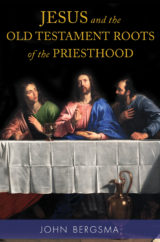By John Bergsma
Dr. John Bergsma is Professor of Theology at the Franciscan University of Steubenville. A former Protestant pastor, Dr. Bergsma has authored several books on Scripture and the Catholic faith, including Jesus and the Old Testament Roots of the Priesthood.

There are two modes of participation in Christ’s priesthood: the common (or royal) and the ministerial. Let’s first look at the common priesthood, the basic priesthood of all Christians.
We see the concept of the common priesthood reflected in several important places in the New Testament, including the famous passage from Romans: “I appeal to you therefore, brethren, by the mercies of God, to present your bodies as a living sacrifice, holy and acceptable to God, which is your spiritual worship” (Rom 12:1).
St. Paul uses priestly language in this passage—“present,” “sacrifice,” “holy and acceptable,” “worship”—all come from the sphere of the temple and priestly service. We Christians are a priesthood and we have a sacrifice to offer—the sacrifice of our bodies. Offering our bodies as living sacrifices is probably not just referring to physical mortifications, but the word “bodies” is most likely a form of metonymy that symbolizes our entire lives.
The body-as-sacrifice is a reality that goes back to Adam’s original priesthood. Recall that Adam’s potential sacrifice was his whole self, which—ultimately—he wasn’t willing to offer to defend his bride. Now that we are baptized into the new Adam, we are called to offer what Adam refused—our very selves. St. Paul’s statement reflects a priestly concept of the whole people of God. This idea isn’t limited to St. Paul. St. Peter, likewise, says to the Church: “But you are a chosen race, a royal priesthood, a holy nation, God’s own people, that you may declare the wonderful deeds of him who called you out of darkness into his marvelous light” (1 Pet 2:9).
There is a place in the Mass where this “priestly soul” of the lay faithful is symbolically represented. It is the liturgical act of offering the gifts. The Roman Missal says: “It is desirable that the faithful manifest their participation in the oblation by bringing forward either bread and wine for the celebration of the Eucharist, or other gifts, for the necessities of the Church and the poor.”
This liturgical act of bringing forward the gifts represents how the common priesthood and the ministerial priesthood together offer worship to God. The unconsecrated bread and wine that you and I might bring forward in Mass and hand over to the ministerial priest represent our bodies as a living sacrifice. They represent our whole lives and all that we do, everything from changing diapers to paying bills to going to work. Essentially, all the events of our daily lives are like the unconsecrated bread and wine. We bring the raw matter of our lives up to ministerial priest, and he takes it and calls the Holy Spirit down upon it, and it becomes the Body of Christ. This shows how our sacrifice is being united to Christ’s. Recall that St. Josemaría said that our personal sacrifices should be offered “in intimate and assiduous union with Christ Jesus in the Holy Sacrifice of the Altar.” Through the prayers and actions of the ministerial priest, the sacrifice of our daily lives in the common world is united to the Eucharistic sacrifice, and together, they become the sacrifice of Christ.
So, the ministerial priest and the common priest have to work together to offer the Eucharistic sacrifice. In a sense, what would the ministerial priesthood do without the common priesthood to bring forward the raw matter of the world? On the other hand, what would we common priests do if we didn’t have the ministerial priesthood to call down the Holy Spirit upon these gifts to sanctify our offerings?
This represents a dynamic that characterizes not just the Eucharistic liturgy but the whole Christian life. It is a dynamic between the common priesthood and the ministerial priesthood. The ministerial priests exist to sanctify what the common priests are doing and to make it a perfect offering.
In the Church we have some members arguing for the ordination of men and women as an expression of the common priesthood. This is a misguided application because the realm of the common priesthood is in the world, in politics, in business, in education, and so on. Professors exercise their common priesthood by bringing the light of Christ to their peers and students. They do this with excellence, and, where appropriate, they show people how their discipline points to a transcendent reality and ultimately to Christ. Those who work in politics are in an excellent position to work for the common good, to uphold the moral order and, again, where appropriate, point to how the political world needs completion in God. We are to exercise our common priesthood by bringing Christ to secular society.
You Might Also Like
In Jesus and the Old Testament Roots of the Priesthood, biblical scholar John Bergsma convinces readers that Jesus did, in fact, intend for a ministerial priesthood to be a key feature of the New Covenant.
Bergsma shows how the priesthood is a major thread holding together the biblical story line—beginning with Adam’s loss of the gift of priesthood in the Fall and the long process of restoring his descendants to a priestly status over the centuries, culminating with Christ.
